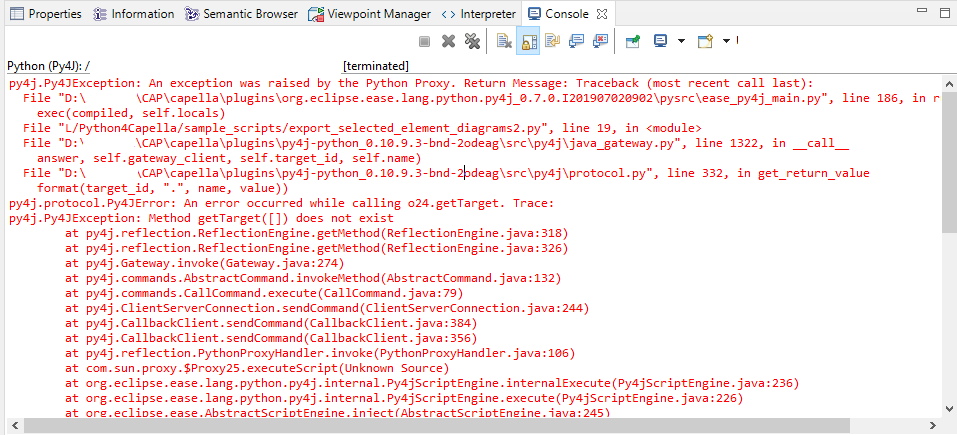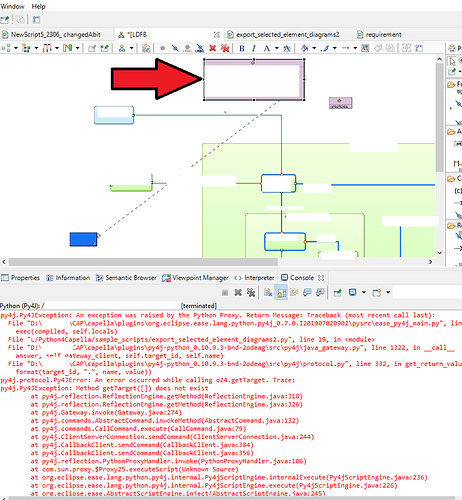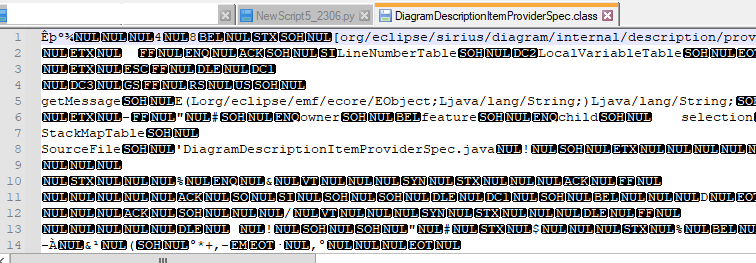Hello,
I have been using:
elem = CapellaElement(CapellaPlatform.getFirstSelectedElement())
to select elements from a diagram.
The problem is that when the element is selected directly in the project explorer, everything works fine, but when the item is selected from a diagram then I would obtain a graphical element/class from Sirius (such as DNode… etc)
Let’s take the examples of both instances for this code:
elem = CapellaElement(CapellaPlatform.getFirstSelectedElement())
print(elem)
print(type(elem))
print(elem.get_id())
print("Test")
print("End of Script")
In both instances the type is “<main.CapellaElement object at 0x00000SomeNumberAdress>”, however their eclass is different (which is displayed only for the actual item, the node has no attribute/fonction for eclass).
When selectring from the diagram, then the item is a node, therefore our script code will naturally produce errors (You cannot get an “id” from a Node I believe, a Node is not an abstract element). The problem will be resolved if the graphical item is replaced with its targeted capella item.
When searching I found a function that gets the target for a diagram object. Click to expand:
class Diagram
class Diagram(JavaObject):
"""
A generic Capella diagram
"""
def __init__(self, java_object = None):
"""
"""
if java_object is None:
JavaObject.__init__(self, create_e_object("http://www.eclipse.org/sirius/1.1.0", "DRepresentationDescriptor"))
elif isinstance(java_object, Diagram):
JavaObject.__init__(self, java_object.get_java_object())
else:
JavaObject.__init__(self, java_object)
def get_uid(self):
"""
"""
return self.get_java_object().getUid()
def set_uid(self, value):
"""
"""
self.get_java_object().setUid(value)
def get_name(self):
"""
"""
return self.get_java_object().getName()
def set_name(self, value):
"""
"""
self.get_java_object().setName(value)
def get_type(self):
"""
"""
if self.get_java_object().getDescription() is None:
return None
else:
return self.get_java_object().getDescription().getName()
def get_package(self):
"""
"""
if self.get_java_object().getTarget() is None:
return None
else:
return self.get_java_object().getTarget().eClass().getEPackage().getName()
def get_description(self):
"""
"""
return self.get_java_object().getDocumentation()
def set_description(self, value):
"""
"""
self.get_java_object().setDocumentation(value)
def get_status(self):
"""
"""
value = Sirius.get_status(self.get_java_object())
if value is None:
return value
else:
return value.getName()
def get_review(self):
"""
"""
return Sirius.get_review(self.get_java_object())
def get_visible_in_documentation(self):
"""
"""
return Sirius.is_visible_in_documentation(self.get_java_object())
def get_visible_for_traceability(self):
"""
"""
return Sirius.is_visible_for_traceability(self.get_java_object())
def get_synchronized(self):
"""
"""
return Sirius.is_synchronized(self.get_java_object())
def get_target(self):
"""
"""
value = self.get_java_object().getTarget()
if value is None:
return value
else:
e_object_class = getattr(sys.modules["__main__"], "EObject")
specific_cls = e_object_class.get_class(value)
return specific_cls(value)
def get_represented_elements(self):
"""
"""
res = []
for element in Sirius.get_represented_elements(self.get_java_object()):
e_object_class = getattr(sys.modules["__main__"], "EObject")
specific_cls = e_object_class.get_class(element)
if specific_cls is not None:
res.append(specific_cls(element))
return res
def get_contextual_elements(self):
"""
"""
return capella_query("org.polarsys.capella.core.semantic.queries.sirius.annotation.eoi.RepresentationToContextualElement", self)
def get_elements_of_interest(self):
"""
"""
return capella_query("org.polarsys.capella.core.semantic.queries.sirius.annotation.eoi.RepresentationToElement", self)
def export_as_image(self, file_path):
"""
status: KO
"""
Sirius.export_image(self.get_java_object(), file_path)
I tried to apply it but failed, I wrote comments next to each line of code, to show the type of error I got:
elem = CapellaElement(CapellaPlatform.getFirstSelectedElement())
print(elem) #<__main__.CapellaElement object at 0x0000021B829CAD08>
print(elem.get_java_object()) # DNodeListEditPart( org.eclipse.gmf.runtime.notation.impl.NodeImp ...
#print(elem.get_java_object().target) #<py4j.java_gateway.JavaMember object at 0x0000021B829D0108>
#print(elem.get_java_object().get_target()) # Method get_target([]) does not exist
print(elem.get_target()) # AttributeError: 'CapellaElement' object has no attribute 'get_target'
print(elem.target) # AttributeError: 'CapellaElement' object has no attribute 'target'
print(type(elem))
print(elem.get_id())
print("Test")
print("End of Script")
I failed to obtain the targeted item using the following:
- .get_java_object().target
- .get_java_object().get_target()
- .get_target()
- .target
What am I missing? How can I obtain the actual target? Thank you.
Edit: I also tried the getTarget():
#print(elem.get_java_object().getTarget())
print(elem.getTarget())
→ AttributeError: ‘CapellaElement’ object has no attribute 'getTarget’


